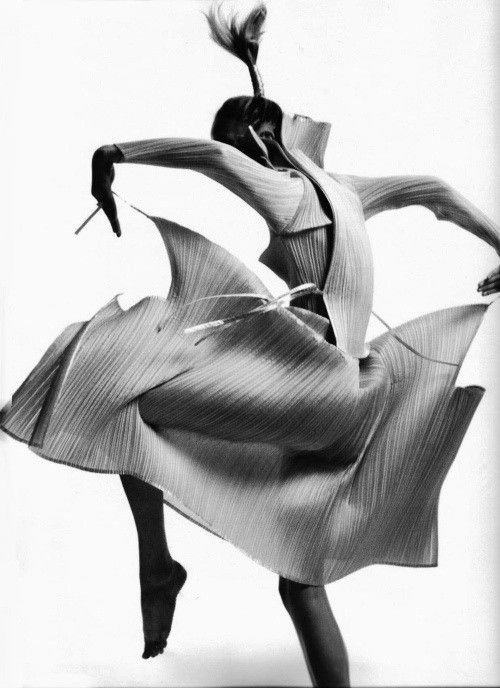Copywriter.
sabukaru.online Article: Issey Miyake’s Lifelong Journey of Mastery
Issey Miayake: A lifelong journey of mastery
When speaking on the growing beast that is the fashion industry, today you need to have it all to become a huge success; new and bold ideas, a marketing strategy to fuel the hunger of the youth, a spark of luck, and a budget which allows you to place yourself in front of the right people. Unfortunately, with today’s trend-thirsty culture, it’s usually not about the next best thing, but the next big thing. Although before this, there was a time where new, conceptual, and imaginative ideas were at the forefront of this bull ride to the top. Where a designer that would push the boundaries and show others how it could be done was awarded the recognition they deserved. There is no better example of this than the legendary and historical individual that calls himself Issey Miyake.
Issey Miyake, originally named Miyake Kazumaru, is a Japanese fashion designer who, amongst a few others, lead the contemporary and experimental movement of the avant-garde Japanese style that is so popular today. Born on April 22, 1938, in Hiroshima, Japan, Miyake was just 7 years old when he survived the Hiroshima bombing; unfortunately, his mother didn’t share the same fate as he would. This would be his very first wave of inspiration and desire to create. Seeing two bridges in the epicenter of the attack, now named Create and Go, these bridges would allow Miyake to know that design can invoke emotion: hope, freedom, and creation in destruction.
Issey Miyake is now world-renowned and a household name, sharing the same weight behind his status among some of the greatest designers in the world. He pushed the boundaries and challenged convention, creating an east meets west story through his garments which would propel him to be a mastermind of the craft. Miyake’s empire now includes over 300 stores worldwide, 8 clothing lines, as well as a line of fragrances for both men and women. A true kingpin of evolution, both from a structural and aesthetical point of view, it would not be a leap to assume that Issey Miyake is one of the most influential and successful designers of our time.
Originally studying graphic design at the Tama Art University in Tokyo, he would graduate in 1965 before moving to Paris, just three months before Kenzo Takada [the first Japanese designer to be successful in Paris]. Kenzo and Miyake actually knew each other in Japan, and both studied together at a tailoring and dressmaking school, l'Ecole de la Chambre Syndicale de la couture. Already designing clothing at this point, Miyake would go on to start his career as an apprentice for French couturier Guy Laroche, and two years later he apprenticed at Givenchy before moving to New York in 1969. It’s hard to believe that Miyake could of one day been making more suave and sophisticated women’s dresses, instead of his now futuristic and experimental industrial creations [including a chair in which doubled as a piece of clothing]. Alas, Miyake had experienced the French riots during his time in Paris which pushed him away from his want to create drapes for ladies who powder their noses and drink fine wine at lunch and instead pushed him to want to create more universally worn pieces. Because of this, it was time to move on to the big apple.
His time in New York was only a short snippet in his career though, as whilst working for a ready-to-wear brand in New York he started to become more interesting in the evolution and development that was happening back in Japan. Just a year later Miyake would venture back to Japan and start to establish himself as a giant, or should we say kaiju, in the fashion industry. He then set up his first studio, the Miyake Design Studio. Just a year later, Miyake would showcase his first collection in New York, mainly t-shirts consisting of Japanese traditional Tattoo designs. 3 years later, Miyake would quickly be recognized as a maestro of the craft. In 1973 he would be invited to Paris with multiple other young and upcoming designers and would move on to set up a boutique there and continue to show his work from that point on in Paris.
As of the 1980s, Issey Miyake was already a well-established and congratulated figure in fashion, and this would only be further enforced with the uprising of two other world-renowned designers that followed in Miyake’s footsteps. Miyake laid the foundations for the avant-garde Japanese style which we all know and love [and most likely can’t afford], but this was further enhanced with Rei Kawakubo, working under the label Comme des Garçons, and Yohji Yamamoto. These two would go on to showcase their work in Paris alongside Miyake in 1981. Although it was never their intention, these 3, with Miyake being the head of the Cerberus of Fashion, would lead a trend of future Japanese avant-garde stylists, creatives, and artists.
After the sale of BAPE, Toby and Sk8thing would join back up with Hishi to be head of production and set up Cav Empt among the darkness of Tokyo. Peculiar really, that they would launch a venture in such an uncertain time, but as is the essence of the enigmatic Cav Empt.
Miyake challenged the convention of western clothing for females at the time. The western trend usually being tight, exposed and hugging of a women’s figure, Miyake instead focuses on simplicity, minimalism, and flowing forms. It was a conscious decision to make it almost go the opposite direction to the westernized ideologies, and Miyake even mentions that this approach was one of his greatest advantages.





